Hanging Curtains
This week: Hanging curtains; Winter fruits; Lemons for life;
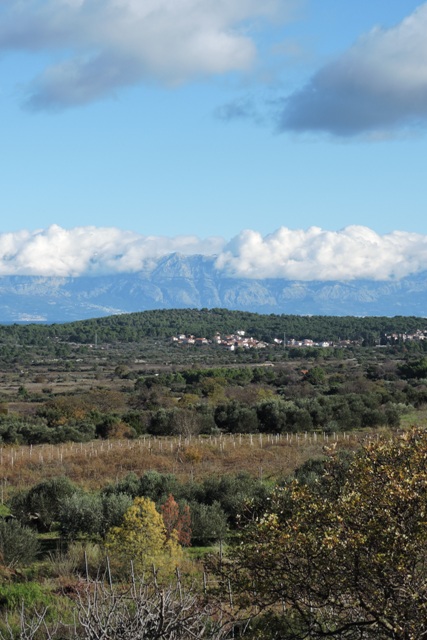
We are on the downhill run to Christmas.
Monday week is Christmas Day, but some how, it just doesn’t feel all that “Christmassy” yet.
In the shops the Christmas decorations have been up for a month. Christmas tunes are being played on the PA systems and adverts from the big supermarkets all feature Christmas themes.
I dug out the posts for my terrace, where I usually hang the Christmas lights. Outdoor Christmas decorations are not a big feature here. Even so, it is nice to have something which people can see.
These are four 2 metre hardwood posts, which I attach to structural uprights on the edge of the terrace and which make it easy to hang a string of lights.
As soon as I brought the posts out, I saw that there was an egg case of a Preying Mantis near the top.
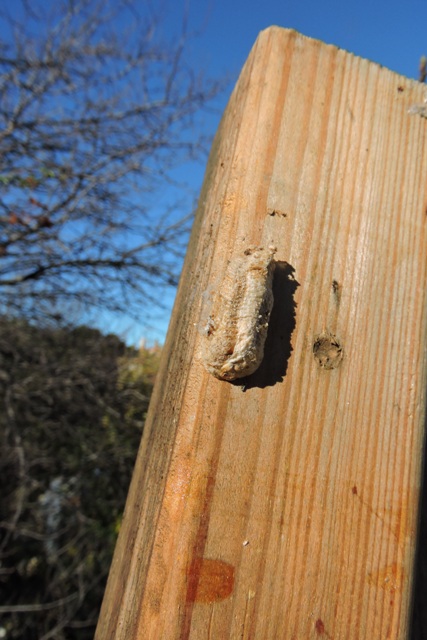
These are exquisitely constructed cellular structures, where the female Mantis lays her eggs during the late summer.
As the days warm in the spring, the eggs hatch into tiny Nymphs. Each one lowers itself to the ground on a silk thread and then makes its own way, unaided into the world.
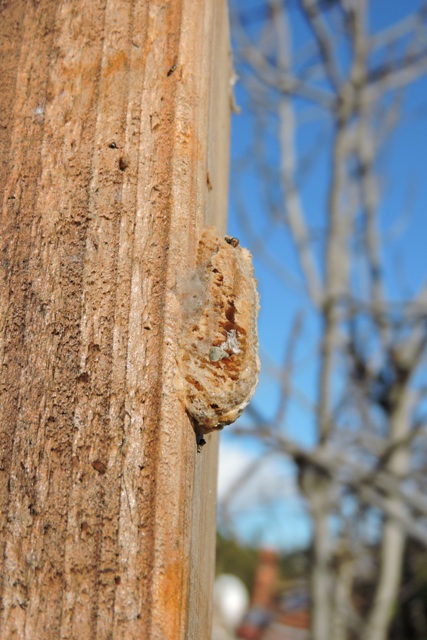
Preying Mantis are a very definite “Gardeners Friend” because of the amount of insects which they consume. They especially like the pests which eat leaves and plants, so I am always happy when I discover egg cases like these.
With the posts in place, it was time to string the ten metre length of LED lights, and attach them to a timer. The lights come on at sunset and then go off at 21:30. Being LED’s, they consume little electricity.
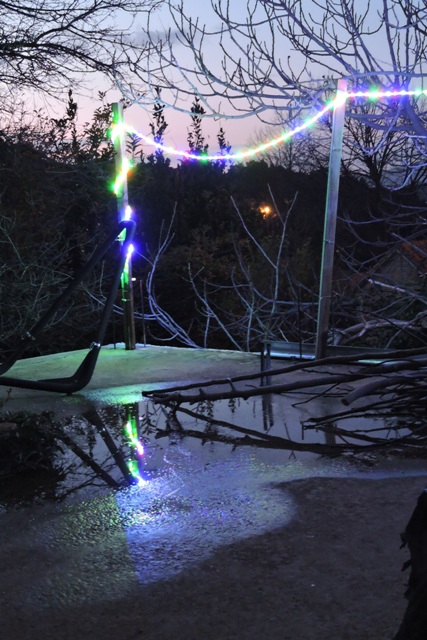
The lights are visible from the lane which leads to my home, and also from the surrounding houses where our other permanent residents live.
Hanging curtains
Way back in January 2017, we experienced a spell of bitter winter weather, when temperatures dropped to -7ºC.
This mid winter cold was compounded by a strong Bura wind which caused water pipes to freeze, water meters to freeze and burst and tender plants to die in the cold.
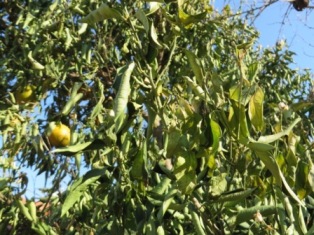
The coldest weeks of the year are usually the last week of December and the first week of January.
By mid January, the sun is higher in the sky, the days are lengthening and spring is in the air.
I have always wrapped my citrus trees to provided some protection from the winter wind. However in 2017, the bubble wrap I used, combined with the young trees I had only planted a couple of years previously, meant that I lost every single citrus tree.
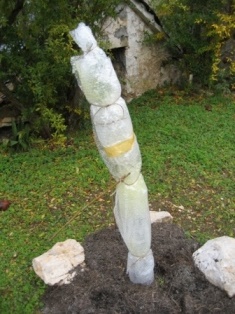
I developed a system using readily available materials, to protect the trees in the citrus orchard in the future.
The frame is rebar steel, in two metre tall hoops over each tree. Onto this I hang green permeable curtains, which protect the trees from wind and cold.

In previous years, I have hung these curtains around the individual trees in late November. Then removing, drying and folding them in March the following year when the chance of damaging winds has passed.
This year I have left it a little late. I think because of the wet November – I don’t work outside in the rain anymore – and the temperatures being mild, I have not prioritised the hanging of the curtains.
Suddenly over the last week it has felt noticeably colder, so I decided I had better get on with the job.
The work has taken me four days to complete, mainly because as the trees have grown, it takes longer to fit the side and top curtain over each tree.
I have also had a lot of help (not) from the felines. They see the material and think it is a great game to crime, pull and roll around in the material.

This definately makes it harder to tension and fix the curtains.
But the job is now finished.
It is another of those tasks on my list of winter jobs which you can easily describe, but it takes much longer to complete than to actually write about the process.
Winter fruits
One shrub I look forward to seeing in Winter is the Beautyberry, Callicarpa dichotoma. . This small and slow growing shrub has inconspicuous pink flowers in the summer.
Then in Autumn, there is a show of colour as the leaves take on hues of yellow and red before dropping, leaving behind clumps of striking purple berries on bare stems.
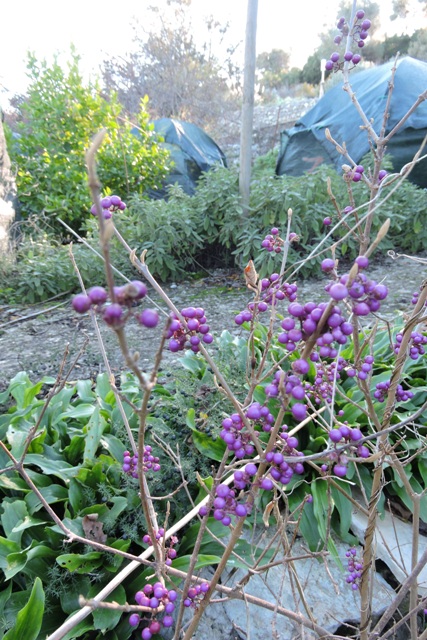
The small berries look like purple pearls, with their highly polished coat. The lustrous finish shines in even the smallest amount of winter sun.
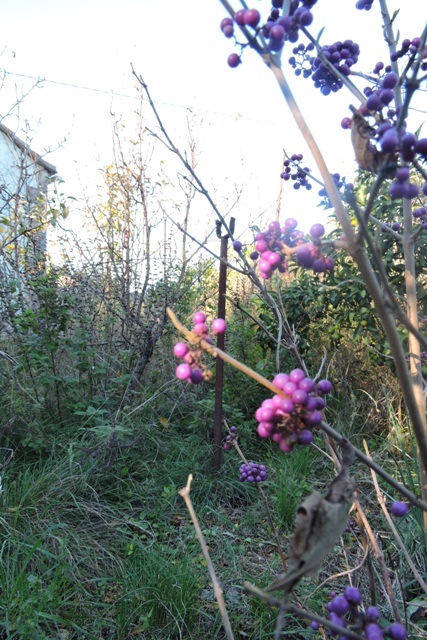
My example has taken six years to reach a height of half a metre. Potentially it will reach two and a half to three meters high.
I suspect this is in part due to the impoverished soil I have around my property.
This shrub likes neutral to acid soil, and all my gardens are alkaline to very alkaline.
Other winter fruits are the Persimmons. I picked the last of them this week and brought them into the utility room to soften before I eat them.
With strong winds forecast for the weekend, I was concerned that the dozen or so remaining fruit would be blown off the tree.
I also aw that my Medlars are ready for picking.
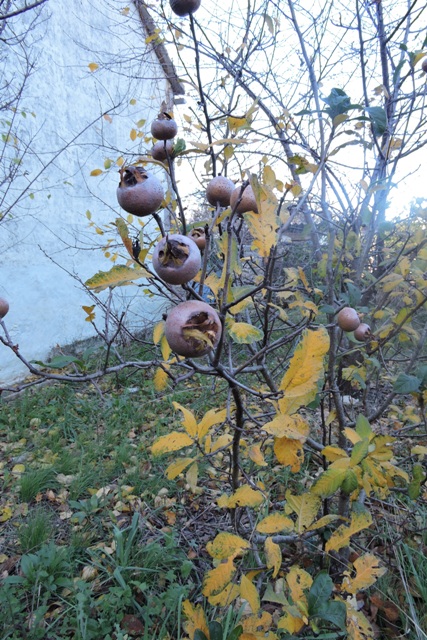
This is another slow growing tree which enjoys the Mediterranean climate.
Medlar fruit are chestnut coloured and need to be “Bletted” before they can be picked. This makes the fruit edible.
There is a short window between the fruit flesh being white, raw and inedible, and after bletting, turning black and mouldy.
These are the reasons why you very seldom see Medlars for sale in supermarkets.
I have a reasonable crop this year and I’m considering making some Medlar Jelly . I have not tried this before but this it might be worth the experiment.
Another recipe I have discovered on line is for Medlar Cheese.
Medlars were extremely popular from the 16th Century and were grown extensively across Europe. Medlar Cheese was a sweet dessert made for Christmas and uses the flesh, which is discarded when making Jelly.
So the two recopies are complimentary.
Lemons for life
2023 has been a little cooler than the previous three years and there has also been a lot more rain.
The precipitation has been more evenly spread across the year too, which has helped keep the soil moist.
The result of this is that some fruit trees have not been as productive, for example my Apricots and Cherry trees, whilst other, like the Citrus have more fruit than I have ever had before.
Although all Citrus are related, like all fruits, there are different varieties and these varieties have different flowering and fruiting patterns.
I have three lemon trees, one is a sweet Meyer lemon, , the other two are standard bitter lemons.
Preparing to hang the netting curtains, as usual I found that the Washinton Navel Oranges had some ripe fruit, some partially ripe fruit and quite a lot of extremely small unripe fruit. This is completely normal.
I picked a dozen of the most ripe fruit and put them in the utility room to ripen fully.
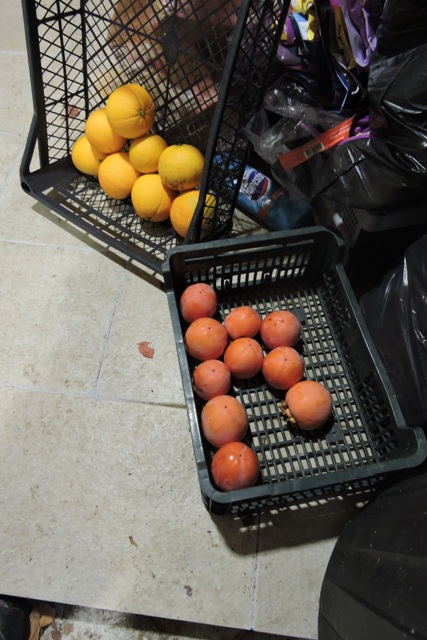
Researching “Ripening” sent me down another of those internet worm holes.
I had in mind that citrus fruits do not ripen once they are removed from the parent tree. Then I wondered how citrus fruits are transported around the world, and how when they appear on a supermarket shelf, they are ripe?
One school of thought is emphatically in the camp that once a citrus fruit is removed, it will not ripen further. There are a large number of articles which support this theory.
However there are also a number of articles which state that citrus fruits do ripen after removal, but do not become any sweeter. This is said to be because fruits like oranges derive sweetness from sugars transported into the fruit from the main plant.
I don’t know enough to be able to decide one way or the other.
What I do know is that my fruits, especially the lemons, will remain on the trees until March or April.
So all the lemons on a late fruiting variety have been left in place, and covered with the wind protection.
A different Lemon variety, where there were substantial numbers of ripe lemons, some recently fallen, I have picked.
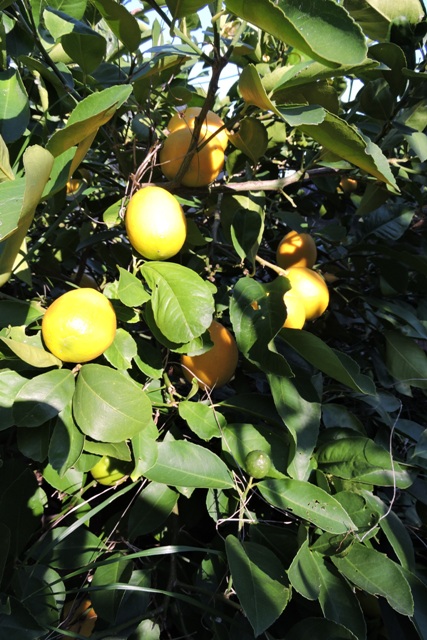
I used to have an old family recipe for making lemon cordial, however I can’t locate it at the moment. I have found a couple of recipes for Lemon Marmalade, so I think as a starter to use some of the pickings, I may try that.
As for the rest, I will be watching through the shade netting to see if fruits start to fall. But if they don’t, I will leave them until the spring before I pick them. NCG